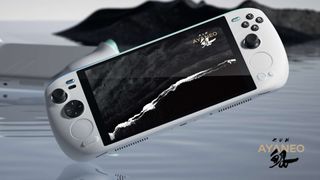A year and a half later and the Steam Deck's trackpads are finally being copied in a new handheld PC
The Ayaneo Kun is the big boi handheld gaming PC, with a chonky battery, and an 8.4-inch 1600p screen for "semi-mobile scenarios."

It's taken nearly a year and a half but finally another handheld gaming PC is launching with a pair of trackpads like the Steam Deck. The Ayaneo Kun is the latest to hit Indiegogo with an official launch set for the end of August, and comes sporting the near ubiquitous Ryzen 7 7840U APU.
Those trackpads have been the only things setting Valve's handheld apart from the raft of AMD-powered devices that have followed it, aside from maybe the somewhat intangible benefits of SteamOS. But those twin pads, set below the thumbsticks, are aiming to provide mouse-like functionality for the benefit of your very PC games.
The original Steam Deck trackpads were built from the ruins of the old Steam Controller. While I am still and forever more not sold on just how effective they are for aping the classic mouse and keyboard control for FPS, it gives gamers on a handheld device far more control for strategy and management games that really don't play nice on controller.
You can play Crusader Kings III on a handheld, but it's not fun. But with even the small trackpads of the Steam Deck you get a pretty decent mouse-like experience.
That's what the Ayaneo Kun is aiming to bring to its big boi handheld, though it's sporting round "innovative dual intelligent touchpads" instead of Valve's square pads. It's hailing this as the first Windows handheld with a touchpad design, and it will be interesting to see how well they function, and just what Ayaneo does with a pair of them.
This isn't the only thing the Kun had going for it, or that is making it stand out from the crowd. It's hoofing big. Bigger than the Steam Deck, and is being pegged by Ayaneo as designed for "semi-mobile scenarios." Basically, you're not going to be slipping it into a pocket on your way out of the house.


But it is running an 8.4-inch screen, with a 1600p native resolution, and that goes some way to justifying the extra scale of the Kun. As does the addition of the 75Wh battery. That's bigger than the ROG Ally or Steam Deck, and chonkier than even the AOKZOE A1 Pro with its 65Wh battery.
The biggest gaming news, reviews and hardware deals
Keep up to date with the most important stories and the best deals, as picked by the PC Gamer team.
The bigger screen might swallow up some of that extra battery capacity, and I also have concerns over how well the otherwise impressive Ryzen 7 7840U will cope with a 2560 x 1600 resolution. I've had the chip gaming happily at 1200p, but 1600p might be a stretch too far for the 12 compute units of its Radeon 780M GPU.
I am still very keen to see how this monster handheld actually feels in the hand, find out how much it costs, and just how much it weighs, too. What I am loving, though, is Ayaneo's continued commitment to these different form factors.

Because, shipping in August is another Ryzen 7 7840U-powered device from the other end of the spectrum: the Ayaneo Air 1S. That's a 5.5-inch 1080p device which is smaller than a Nintendo Switch and almost as light. There is a specific thin and light version that's actually lighter and very thin—at 18mm—but the battery is a measly 28Wh and will struggle to last. Even on the non-thin and light version the battery is only a 38Wh option, which is going to be tight on gaming up time, too.
It's also announced the Ayaneo Slide, a gaming handheld with a slide out screen with an adjustable angle, and an RGB-backlit keyboard underneath. That is coming out after the Kun, however, so will be launching closer to the end of the year.
That's a lot of Ryzen 7 7840U machines, but it does mean there are a lot of different handheld gaming PCs coming out, with potentially fascinating specs lists and form factors that ought to suit most of our playtimes.

Dave has been gaming since the days of Zaxxon and Lady Bug on the Colecovision, and code books for the Commodore Vic 20 (Death Race 2000!). He built his first gaming PC at the tender age of 16, and finally finished bug-fixing the Cyrix-based system around a year later. When he dropped it out of the window. He first started writing for Official PlayStation Magazine and Xbox World many decades ago, then moved onto PC Format full-time, then PC Gamer, TechRadar, and T3 among others. Now he's back, writing about the nightmarish graphics card market, CPUs with more cores than sense, gaming laptops hotter than the sun, and SSDs more capacious than a Cybertruck.
Most Popular





